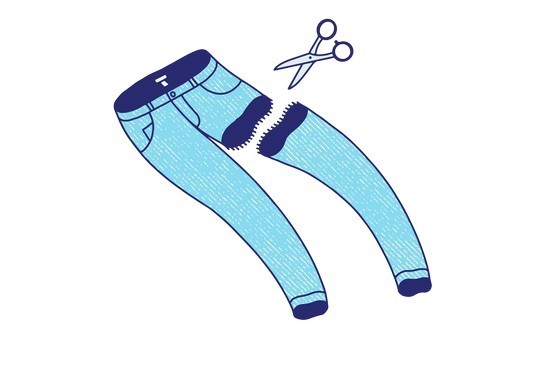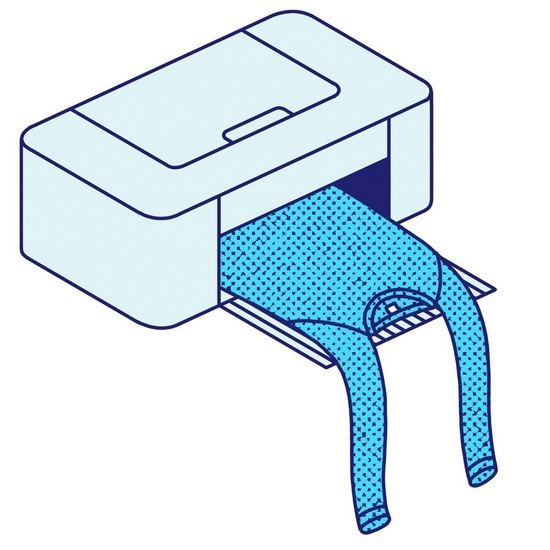Dressing for hot: How a warming planet is changing what we wear
New York Times
last updated: Sep 07,2022

Shirts made from the same polymer as
plastic bags. Jeans infused with crushed jade. Garments constructed using
computerized knitting for superior ventilation, or made with cooling technology
designed for astronauts by NASA.اضافة اعلان
As climate change brings more intense heat waves, the next frontier in climate resilience is the clothing we wear, with innovations that promise to cool and dry the hot and sweaty masses. They could make life more bearable for construction workers, farmers, soldiers, and others who cannot retreat indoors as days and nights get hotter.
Clothing designed for heat is moving from a niche product into the mainstream, said Lorna Hall, director of fashion intelligence for WGSN, a company that tracks and forecasts consumer trends.

But the industry’s response to rising temperatures also illustrates the challenges of adapting to climate change. The most promising options tend to be the most expensive. Consumers must navigate confusing or questionable claims. And improvements in one area almost always entail trade-offs elsewhere.
Here is a look at some of the garments already available, and others on their way — and what they reveal about the challenges of dressing for a warming world.
The limits of just wearing less
In some ways, less is best when dressing for heat, according to George Havenith, a professor of environmental physiology at Loughborough University in England.
“A lot of bare skin,” Havenith said. “It tends to make quite a bit of difference.”
Witness the push to make shorts acceptable officewear. Even unbuttoning a collar can help. During a heat wave this summer, Spain’s prime minister, Pedro Sánchez, asked public officials and private sector workers to stop wearing neckties, which he said would reduce the need for air conditioning and thus save energy.
In the past five years, changes in weather alone have increased sales of shorts and sandals by half a percentage point, while reducing sales of fleece and outerwear by 1 percent, according to Evan Gold, executive vice president at Planalytics, a company that quantifies the impact of weather on consumer demand.

Given the size of the market those changes represent a significant amount of money, Gold said.
Staying cool is not cheap
Whether clothing keeps you cool revolves largely around breathability — the amount of air flow that permeates the fabric, carrying heat away from the skin. There are any number of ways to improve air flow, including the selection of fabric, the space between the fibers, and the thinness of the material.
But clothing must also be dense enough to shield against ultraviolet rays. And it needs to be tough enough to endure multiple washings.
Some cultures in historically hot climates, such as in North Africa and South Asia, have instructive traditions for dressing in heat, like loose-fitting clothes or covering much of the body. Though recently, designers around the world have been trying to solve the heat problem with technology.
Among the most affordable examples is Uniqlo’s AIRism T-shirt ($15), which comes in a polyester-and-spandex version, and another made of 71 percent cotton, mixed with 25 percent polyester and 4 percent spandex.
The polyester-spandex version is clingy, creating a sensation uncomfortably close to wrapping one’s upper body in Saran wrap. The cotton version, by contrast, feels pleasant at first, creating an initial cooling effect. But when worn in the heat, it sticks to the skin, producing a sensation akin to cold sweats. A spokesperson for Uniqlo said the shirt had been positively received by customers.

Slightly higher up the cost curve, Dickies’ Cooling Temp-iQ T-shirt ($20), a 50-50 blend of cotton and polyester, promises an “INSTANT COOLING SENSATION.” A spokesperson for the company said it employed “an advanced body temperature technology that is designed to either cool or warm in response to your body’s signals.” But the garment, though comfortable against the skin, created no perceptible cooling sensation, instant or otherwise.
One shirt that had a noticeably cooling effect was made by LifeLabs, a company that emerged from a research lab at Stanford University. Its $49 CoolLife Tee is made from polyethylene, the same polymer used in plastic bags. It produced a cool feeling, not unlike walking barefoot on a tile floor.
Computerized knitting and spacesuits
For a similar price, Ministry of Supply, a company in Boston founded by former Massachusetts Institute of Technology students, sells the Atlas Tee ($48). The shirt is constructed using computerized knitting, a technology similar to 3D printing that makes it possible to create additional space between the strands of material, according to Gihan Amarasiriwardena, the company’s co-founder and president.
The result is a garment that feels slightly thicker than a standard shirt, as if wearing light padding. Yet it also feels cool, even under other garments.
But the process means the shirts cannot yet be mass-produced, which means higher prices. Each Atlas shirt costs Ministry of Supply $9.60 to produce, Amarasiriwardena said — four times what it might cost a typical clothing manufacturer.
Other garment makers use different high-tech tools.
Kontoor Brands, a North Carolina-based company that owns Wrangler and Lee, said it will begin selling “Insta-Cool” shirts in the US next year with an updated version of a technology called phase-change material, first designed by NASA to cool astronauts. The shirts are already available in Asia.

The technology involves printing ink made from wax and other materials on portions of the interior of the shirt, which act as a heat sink, according to Dhruv Agarwal, the company’s senior director for innovation, sustainability, and product development. The approach creates a noticeable and lasting cooling effect, based on a sample provided by the company.
Kontoor also sells jeans in Asia that are infused with bits of jade crushed into powder and blended into the fabric. The idea is to transfer the cooling sensation of stone into the garment, Agarwal said.
To wick or not to wick
Sweat is the body’s natural cooling mechanism. And it poses a complicated challenge to manufacturers of cool clothing.
Most garments that companies market as cooling also promise to keep their wearers dry by wicking sweat away from the skin. But too much wicking can be counterproductive, according to Glen Kenny, a professor of physiology at the University of Ottawa.
Sweat cools through evaporation, a process that transfers heat from the body into the air. The closer to the skin that evaporation takes place, the more heat energy it consumes in the process; when clothing moves sweat away from the skin, it keeps the body dry but renders evaporation less efficient at cooling, Kenny said.
“There’s a misguided belief that wicking away that sweat from the skin is somehow going to keep the body cool,” he said.
Sweat-wicking clothing primarily makes people feel comfortable — a different goal from cooling. Kenny recalled hearing from miners who tried to deal with the heat by coming to their jobs wearing sweat-wicking undergarments. “It made the situation worse,” he said.
Climate trade-offs
In some cases, making clothing better suited to heat can exacerbate other climate problems.
One of the most breathable natural fibers is cotton. But growing enough crop for around 0.5kg of cotton fiber requires almost 1,324 liters of water in a good year, according to data provided by the Agricultural Research Service at the US Department of Agriculture (USDA).
The best type of cotton for heat is often called Pima or Egyptian cotton, which makes garments that are thinner and lighter. Yet growing Pima requires even more water than lower-quality cotton, according to the USDA — in some cases, twice as much.
That trade-off between breathability and sustainability is a conundrum, said Sara Kozlowski, vice president at the Council of Fashion Designers of America, an industry group.
Still, natural fibers like cotton are at least biodegradable. Sweat-wicking polyester, by comparison, is made from petroleum and can take decades or more to decompose — another challenge for clothing manufacturers already under pressure from environmentalists.
For designers, navigating those competing demands “is incredibly hard,” Kozlowski said.
Read more Fashion
Jordan News
As climate change brings more intense heat waves, the next frontier in climate resilience is the clothing we wear, with innovations that promise to cool and dry the hot and sweaty masses. They could make life more bearable for construction workers, farmers, soldiers, and others who cannot retreat indoors as days and nights get hotter.
Clothing designed for heat is moving from a niche product into the mainstream, said Lorna Hall, director of fashion intelligence for WGSN, a company that tracks and forecasts consumer trends.

But the industry’s response to rising temperatures also illustrates the challenges of adapting to climate change. The most promising options tend to be the most expensive. Consumers must navigate confusing or questionable claims. And improvements in one area almost always entail trade-offs elsewhere.
Here is a look at some of the garments already available, and others on their way — and what they reveal about the challenges of dressing for a warming world.
The limits of just wearing less
In some ways, less is best when dressing for heat, according to George Havenith, a professor of environmental physiology at Loughborough University in England.
“A lot of bare skin,” Havenith said. “It tends to make quite a bit of difference.”
Witness the push to make shorts acceptable officewear. Even unbuttoning a collar can help. During a heat wave this summer, Spain’s prime minister, Pedro Sánchez, asked public officials and private sector workers to stop wearing neckties, which he said would reduce the need for air conditioning and thus save energy.
In the past five years, changes in weather alone have increased sales of shorts and sandals by half a percentage point, while reducing sales of fleece and outerwear by 1 percent, according to Evan Gold, executive vice president at Planalytics, a company that quantifies the impact of weather on consumer demand.

Given the size of the market those changes represent a significant amount of money, Gold said.
Staying cool is not cheap
Whether clothing keeps you cool revolves largely around breathability — the amount of air flow that permeates the fabric, carrying heat away from the skin. There are any number of ways to improve air flow, including the selection of fabric, the space between the fibers, and the thinness of the material.
But clothing must also be dense enough to shield against ultraviolet rays. And it needs to be tough enough to endure multiple washings.
Some cultures in historically hot climates, such as in North Africa and South Asia, have instructive traditions for dressing in heat, like loose-fitting clothes or covering much of the body. Though recently, designers around the world have been trying to solve the heat problem with technology.
Among the most affordable examples is Uniqlo’s AIRism T-shirt ($15), which comes in a polyester-and-spandex version, and another made of 71 percent cotton, mixed with 25 percent polyester and 4 percent spandex.
The polyester-spandex version is clingy, creating a sensation uncomfortably close to wrapping one’s upper body in Saran wrap. The cotton version, by contrast, feels pleasant at first, creating an initial cooling effect. But when worn in the heat, it sticks to the skin, producing a sensation akin to cold sweats. A spokesperson for Uniqlo said the shirt had been positively received by customers.

Slightly higher up the cost curve, Dickies’ Cooling Temp-iQ T-shirt ($20), a 50-50 blend of cotton and polyester, promises an “INSTANT COOLING SENSATION.” A spokesperson for the company said it employed “an advanced body temperature technology that is designed to either cool or warm in response to your body’s signals.” But the garment, though comfortable against the skin, created no perceptible cooling sensation, instant or otherwise.
One shirt that had a noticeably cooling effect was made by LifeLabs, a company that emerged from a research lab at Stanford University. Its $49 CoolLife Tee is made from polyethylene, the same polymer used in plastic bags. It produced a cool feeling, not unlike walking barefoot on a tile floor.
Computerized knitting and spacesuits
For a similar price, Ministry of Supply, a company in Boston founded by former Massachusetts Institute of Technology students, sells the Atlas Tee ($48). The shirt is constructed using computerized knitting, a technology similar to 3D printing that makes it possible to create additional space between the strands of material, according to Gihan Amarasiriwardena, the company’s co-founder and president.
The result is a garment that feels slightly thicker than a standard shirt, as if wearing light padding. Yet it also feels cool, even under other garments.
But the process means the shirts cannot yet be mass-produced, which means higher prices. Each Atlas shirt costs Ministry of Supply $9.60 to produce, Amarasiriwardena said — four times what it might cost a typical clothing manufacturer.
Other garment makers use different high-tech tools.
Kontoor Brands, a North Carolina-based company that owns Wrangler and Lee, said it will begin selling “Insta-Cool” shirts in the US next year with an updated version of a technology called phase-change material, first designed by NASA to cool astronauts. The shirts are already available in Asia.

The technology involves printing ink made from wax and other materials on portions of the interior of the shirt, which act as a heat sink, according to Dhruv Agarwal, the company’s senior director for innovation, sustainability, and product development. The approach creates a noticeable and lasting cooling effect, based on a sample provided by the company.
Kontoor also sells jeans in Asia that are infused with bits of jade crushed into powder and blended into the fabric. The idea is to transfer the cooling sensation of stone into the garment, Agarwal said.
To wick or not to wick
Sweat is the body’s natural cooling mechanism. And it poses a complicated challenge to manufacturers of cool clothing.
Most garments that companies market as cooling also promise to keep their wearers dry by wicking sweat away from the skin. But too much wicking can be counterproductive, according to Glen Kenny, a professor of physiology at the University of Ottawa.
Sweat cools through evaporation, a process that transfers heat from the body into the air. The closer to the skin that evaporation takes place, the more heat energy it consumes in the process; when clothing moves sweat away from the skin, it keeps the body dry but renders evaporation less efficient at cooling, Kenny said.
“There’s a misguided belief that wicking away that sweat from the skin is somehow going to keep the body cool,” he said.
Sweat-wicking clothing primarily makes people feel comfortable — a different goal from cooling. Kenny recalled hearing from miners who tried to deal with the heat by coming to their jobs wearing sweat-wicking undergarments. “It made the situation worse,” he said.
Climate trade-offs
In some cases, making clothing better suited to heat can exacerbate other climate problems.
One of the most breathable natural fibers is cotton. But growing enough crop for around 0.5kg of cotton fiber requires almost 1,324 liters of water in a good year, according to data provided by the Agricultural Research Service at the US Department of Agriculture (USDA).
The best type of cotton for heat is often called Pima or Egyptian cotton, which makes garments that are thinner and lighter. Yet growing Pima requires even more water than lower-quality cotton, according to the USDA — in some cases, twice as much.
That trade-off between breathability and sustainability is a conundrum, said Sara Kozlowski, vice president at the Council of Fashion Designers of America, an industry group.
Still, natural fibers like cotton are at least biodegradable. Sweat-wicking polyester, by comparison, is made from petroleum and can take decades or more to decompose — another challenge for clothing manufacturers already under pressure from environmentalists.
For designers, navigating those competing demands “is incredibly hard,” Kozlowski said.
Read more Fashion
Jordan News


